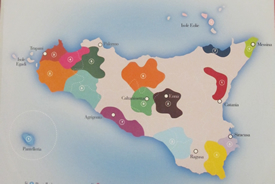 The Sicilians are often portrayed as very proud of their island’s identity and culture and it is not uncommon for people to describe themselves as Sicilian rather than as Italians, and Sicily as a continent. It is the largest island in the Mediterranean, covering about 25,708 sq km with a population of about 5 million people. Besides the Capital city of Palermo other main cities include Catania, Messina and Syracuse though several smaller towns like Ragusa, Noto, Agrigento, Menfi and Vittoria also add to the wine landscape. Its economy is still mostly based on agriculture, especially vineyards, orange and lemon orchards, which profit from its excellent micro-climate, Mediterranean sun and mild winters. The Sicilians are often portrayed as very proud of their island’s identity and culture and it is not uncommon for people to describe themselves as Sicilian rather than as Italians, and Sicily as a continent. It is the largest island in the Mediterranean, covering about 25,708 sq km with a population of about 5 million people. Besides the Capital city of Palermo other main cities include Catania, Messina and Syracuse though several smaller towns like Ragusa, Noto, Agrigento, Menfi and Vittoria also add to the wine landscape. Its economy is still mostly based on agriculture, especially vineyards, orange and lemon orchards, which profit from its excellent micro-climate, Mediterranean sun and mild winters.
Sicily has been known for its wealth of archaeology since ancient times, as it has been conquered by the Greeks, Romans, Byzantines, Normans and Spaniards, each contributing to the island’s culture, particularly in the areas of cuisine and architecture, making it a tourist paradise, besides bringing in several different grape varieties that have made it unique in terms of having local grapes that grow only or mostly in this region.
Until the early 1980s, Sicily was primarily producing vast quantities of bulk wine used for blending wines of the north and often shipped as far as France. However, during the last 30 years the quality has improved substantially. The most significant changes took place in the mid-1980s thanks to the work of several family estates like Planeta, Donnafugata and Tasca d’Almerita, still considered the benchmark of Sicilian wines today. Following the example of Planeta, they have established their reputation by planting international grape varieties also.
Renaissance of Sicily
“It was necessary to reassure the world that Sicily could produce quality wines and not just bulk wine,” explains Diego Planeta, president of the island’s largest co-op winery, Settesoli. He planted Chardonnay, Merlot and Cabernet Sauvignon, and took on winemakers with international experience in winemaking in hot climates, particularly from Australia. La Segreta label from Planeta proved that good value quality wines could be made from Sicily, and their emergence could be considered the moment of Sicily’s Renaissance.
International varietals led the way into the markets, yet at the same time, wine consultants such as Giacomo Tachis (The winemaker behind Sassicaia for over 40 years and Decanter Man of the 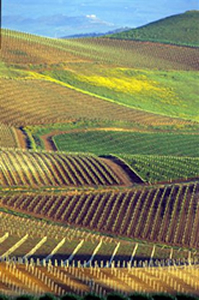 Year 2011) and agronomist Professor Attilio Scienza –both working with Sicily’s Regional Institute for Wine and Viticulture-Istituto Regionale della Vite e del Vino (IRVV), believed in the potential of Sicily’s indigenous varietals. Year 2011) and agronomist Professor Attilio Scienza –both working with Sicily’s Regional Institute for Wine and Viticulture-Istituto Regionale della Vite e del Vino (IRVV), believed in the potential of Sicily’s indigenous varietals.
Over the past 20 years, the IRVV and its consultants have contributed enormously to establishing vineyard management, research, and clonal selection of its main indigenous varietals, such as Nero d’Avola, Carricante, Nerello Mascalese, Catarratto and Inzolia, which today represent the face of Sicilian wines.
Sicily still has to sort out some issues before it can move successfully into the international markets. Its potential in exports is greatly under-exploited, with less than 10% of total production exported. Most producers think that if there were less fragmentation and more cohesion among producers, promotion could be more effective and export sales would increase.
IRVV has the goal of creating a viable system of promotion under one umbrella. It oversees the issues of quality control, research, training in viticulture and vinification, yielding positive results. “Of course there are still some producers lagging behind, but on the whole the increase in quality production is still unknown to the outside world. This is why we really need to focus our attention on communicating to the consumer,” says Dario Cartabellotta, the managing director of IRVV. “Making good wine is not enough. We need to get the message across though commercial channels, where sales figures demonstrate our growing potential.”
According to Cartabellotta the second important ‘Renaissance’ currently taking place with Sicilian wine is the communication of its quality to the rest of the world. Cartabellotta explains: “We are targeting international markets and taking part in international shows, as well as organizing events with importers and opinion leaders here in Sicily, in order to communicate the excellence of our wines and the uniqueness of our territory.”
Sicily’s top offerings are considered world-class wines that compare favourably with top wines from all over the world, and consumer interest in varietals like Nero d’Avola and, to a lesser extent, Grillo and Inzolia has never been higher. At current price levels Sicilian wines provide interesting alternatives to offerings from other areas, but it may be difficult for these brands to reach large volumes, some importers feel.
IGT vs. DOC Sicilia
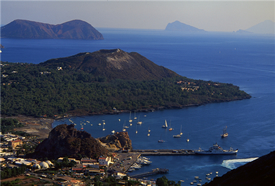 Sicily has 22 DOC areas of production and only one DOCG- Cerasuolo di Vittoria. Most wine is still labeled as IGT Sicilia. “This gives us more freedom and allows us to bottle single varietal wines, with the mention of the grape variety on the label, which is not possible under the DOC denomination,” says Giuseppe Monaco, export manager of Cantine Nicosia. Sicily has 22 DOC areas of production and only one DOCG- Cerasuolo di Vittoria. Most wine is still labeled as IGT Sicilia. “This gives us more freedom and allows us to bottle single varietal wines, with the mention of the grape variety on the label, which is not possible under the DOC denomination,” says Giuseppe Monaco, export manager of Cantine Nicosia.
Sicily’s ongoing debate over the recently created DOC Sicilia is the hottest issue disputed among producers. Historically sold in bulk and cheap in international markets, these wines create friction between wineries in Sicily and those bottling them outside Sicily, an issue that the new DOC Sicilia attempts to regulate. “The only reason that justifies creating the DOC Sicilia is to regulate and obligate the bottling of Sicilian wine in Sicily,” comments Fabio Piccoli, an author and international marketing consultant to a number of Italian consortiums, including Sicily. “However, this at present is not possible, since the EU will not change the bottling rights which have been acquired over the past ten years by a number of large bottlers outside Sicily and Italy.”
The DOC Sicilia is necessary as long as the identity of the individual DOCs is retained,” says Professor Scienza. “DOCs such as Etna and Pantelleria should be upgraded to DOCGs and historic DOCs such as Menfi and Marsala should stand fast. The DOC Sicilia is necessary to regulate IGT Nero d’Avola and Inzolia, which is bottled outside Italy with no quality or authenticity control, and sold at outrageously cheap prices.”
Popular Grape Varietals
Many grapes types are grown in Sicily, used either ‘in purezza’ (single grape variety wines), or blended. Some have been around for centuries, others are more recent imports. The following are some of the main varieties:
Red grapes: Nero D’Avola, Nerello Mascalese, Nerello Cappuccio, Nerello Mantellato, Perricone, Frappato, Calabrese, and the more recently introduced Merlot, Cabernet Sauvignon, Cabernet Franc and Shiraz (Syrah).
Nero D’Avola (also called Calabrese) is one of the oldest indigenous grapes and Sicilian winemakers are justifiably proud of the recognition that this variety is receiving. It is a hearty with soft tannins and can be drunk at an early age as a fruitier, berry style or aged for greater complexity.
Frappato Usually produced in its pure form, it presents a light, refreshing wine, with a full bouquet, low tannin content, and notable acidity. This is used as a key component of the Cerasuolo di Vittoria DOCG wine along with Nero d’Avola.
Nerello Mascalese and Cappuccio The two main red varieties grown on Mount Etna. Due to the rich mineral soils the cooler micro-climate and the steeper exposure, they produce elegant mineral wines capable of good ageing.
White grapes: Catarratto, Grecanico, Grillo, Inzolia (Insolia/Ansonica Bianca), Zibibbo, Damaschino, Trebbiano, Moscato Bianco and the more recently introduced Chardonnay, Viognier and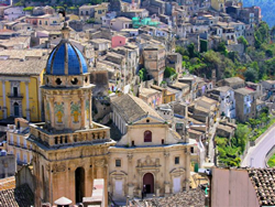 Fiano. Fiano.
Carricante A distinctive white wine from the Etna area with minerality and a fresh citrus touch to it.
Catarratto Bianco A white wine, traditional in the Trapani area, it is fairly full bodied and used in Marsala wine, characterized by a delicate flavour tending to citrus notes.
Grecanico (Greco) A white so-called for its Greek origins. It is a crisp, apple-flavoured grape with an almond-like finish.
Inzolia, Insolia or Ansonica Commonly found all over Sicily, it produces delicious whites with delicate floral aromas.
Malvasia Round, fleshy variety, can be full-bodied, with fresh peach and apricot notes.
Zibibbo (Moscatellone). A variety of Muscat grape introduced by the Saracen Arabs during the 9th century, used in fortified wines and also as a varietal. Ripe, honey nose- can be vinified in the dry as well as sweet style
Grillo Full-bodied white used in Marsala and Alcamo blends among others. Crisp and light in texture, with moderate acidity and notable sweetness.
Wine Styles of Sicily
Microclimate and soils in Sicily vary enormously with grapes grown from the western coastal areas of Palermo, Trapani and Agrigento, with its torrid climates and sandy soils, to the South-eastern areas of Ragusa, Syracuse and the more northern cooler climes of Etna, with its mineral-rich soils.
Within this panorama it is possible to sample a range of wine styles, from fruity concentration to deep elegance, detecting a notable distinction in wines made from the same grape variety grown in different parts of the island.
Marsala is a quality fortified wine, based on the white varieties of Grillo, Catarratto, Inzolia and Damaschino. This is a part of the country’s historical wealth but the style seems to be dying a slow death.
When it comes to other styles, the future looks much brighter. Recent changes in the style of wines show that Sicilian wines are veering away from the chunky, overripe, over-oaked wines to more fruit-forward wines showing elegance, balance and lower levels of alcohol. The IRVV is currently engaged in a research programme to bring down the level of alcohol with the use of specific yeast which lowers the sugar level, diminishing the alcohol content while increasing the level of glycerin. The other study is based on early harvesting, allowing the grapes to ripen and reach phenolic maturity while lowering the sugar content and alcohol level by 1% to 1.5%, producing wines of structure, yet more aromatic, not over 12.5%-13% alcohol.
The emblem of Sicilian wine is still Nero d’Avola, in terms of both plantings and popularity. It’s planted in18,830 hA , second only to the white indigenous variety Catarratto, which covers 32,903 hectares. A total of 41,569 hA of Sicilian vineyards are cultivated with red grapes while 73,824 hA are planted with white varieties.
Nero d’Avola-the Terroir wine
Nero d’Avola does well in most of Sicily, according to Alessio Planeta of Planeta. This is a Terroir wine, changing its character depending on where it is planted. “If you are looking to produce a modern style of wine, characterized by a rounded, fruity appeal and easy drinking, however, not particularly good for ageing, then Menfi and Sambuca in western Sicily are the best areas to plant Nero d’Avola,” explains Planeta, “whereas if you are looking for a more complex Cru showing elegance, aromas and acidity with good ageing potential, then the area of Noto, Vittoria and Ragusa in the southeast are excellent. Contea di Sclafani in the centre of Sicily is another area with excellent potential, yielding age worthy and structured wines with bold fruit.”
Active volcanic Etna
The most recent trend in Sicily is the growing interest in wines from Etna, characterized by its steep slopes and terraced vineyards of ancient bush-trained vines showing the depth and finesse of more celebrated northern European wines. In recent months, Nerello Mascalese and Nerello Cappuccio from the unique volcanic terroir of Mount Etna have gained a lot of attention on account of their distinct flavor profile. Top labels of Etna Rosso DOC, made with a blend of local grapes Nerello Mascalese and Nerello Cappuccio, can be complex and refined with real cellaring potential, as can the smaller quantities of Etna Bianco DOC, predominantly made with Carricante grapes.
Women winemakers bringing elegance
The changes are not only taking place in wine styles and varietals. Sicily’s agricultural sector was historically male dominated, concentrating on powerful wines lacking elegance. According to Cartabellotta, “The future of Sicilian production is in the hands of Sicily’s women winemakers. Thanks to them, the style of Sicily’s wines are changing to a more tasteful, elegant refined style of production”
Michele Shah
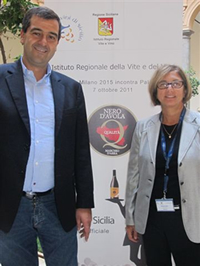 Sicily’s Regional Institute for Wine and Viticulture-Istituto Regionale della Vite e del Vino (IRVV) is organizing Master Class in Sicily-Soil, Terroir and Wines in India for the first time in January 2012. Subhash Arora, President of Indian Wine Academy, who has been to Sicily several times will present the Master Class with the assistance of the author of this Article and Fabio Piccoli, the international consultant- both experts of Sicilian wines, at Hyatt Regency, Delhi (January 10), Hyatt Regency, Kolkata (January 11), Trident Bandra- Kurla, Mumbai (January 13) and Hyatt Regency, Pune (January 14) to introduce a select group of wine professionals to this beautiful jewel of Mediterranean. Around a dozen wines from diffrent parts of Sicily from producers mentioned in her Article including Nicoasa, Tasca d'Almarita and Settessoli and many other passionate producers, will be showcased at this Master Class- several being much awarded and highly rated by critics and wine guides. The Director of IRVV, Mr. Dario Cartabellotta will also be present along with some of the most representative producers to disseminate the relevant information about the distinctive features of Sicilian wines and answer any queries. For any more information about this never-before organised interesting event, you may contact info@indianwineacademy.com –editor. Sicily’s Regional Institute for Wine and Viticulture-Istituto Regionale della Vite e del Vino (IRVV) is organizing Master Class in Sicily-Soil, Terroir and Wines in India for the first time in January 2012. Subhash Arora, President of Indian Wine Academy, who has been to Sicily several times will present the Master Class with the assistance of the author of this Article and Fabio Piccoli, the international consultant- both experts of Sicilian wines, at Hyatt Regency, Delhi (January 10), Hyatt Regency, Kolkata (January 11), Trident Bandra- Kurla, Mumbai (January 13) and Hyatt Regency, Pune (January 14) to introduce a select group of wine professionals to this beautiful jewel of Mediterranean. Around a dozen wines from diffrent parts of Sicily from producers mentioned in her Article including Nicoasa, Tasca d'Almarita and Settessoli and many other passionate producers, will be showcased at this Master Class- several being much awarded and highly rated by critics and wine guides. The Director of IRVV, Mr. Dario Cartabellotta will also be present along with some of the most representative producers to disseminate the relevant information about the distinctive features of Sicilian wines and answer any queries. For any more information about this never-before organised interesting event, you may contact info@indianwineacademy.com –editor.
|